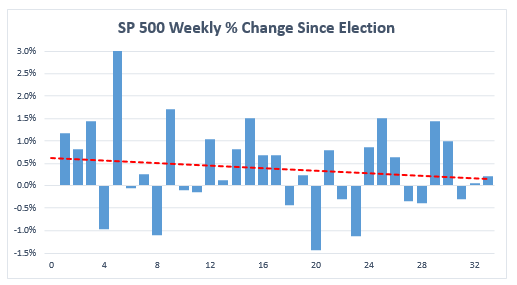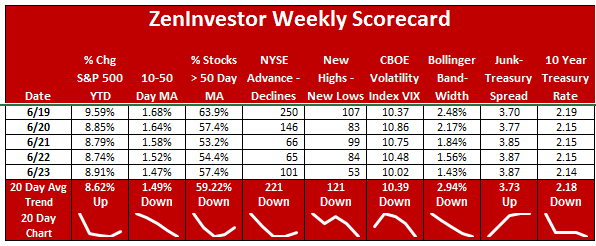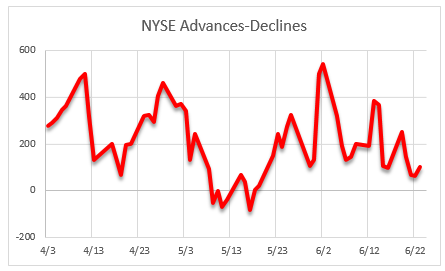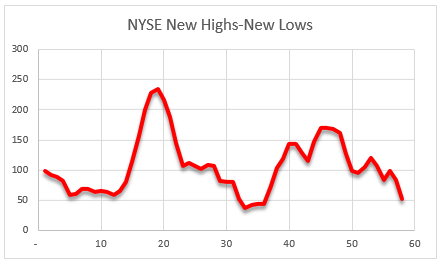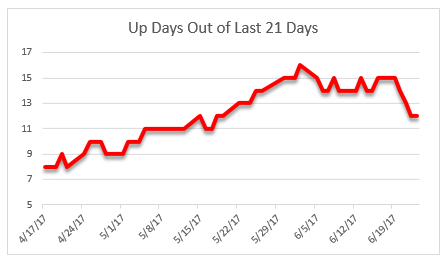Highlights
- The post-election rally is still intact, but losing steam.
- The S&P 500 is up 14% since the election
- The Dow, S&P, and NASDAQ are all making new highs.
- Investor optimism is still high, but starting to waver a bit.
- A correction of 10% or so would probably be good for this overstretched market.
Trump rally still intact but losing steam
The fact that investors are still optimistic about tax cuts, infrastructure spending, deregulation and health care reform is evident in the above chart. But sharp-eyed readers will notice a dampening of momentum since March 1st.
The weekly chart since the election shows the slowdown more clearly
The 8-year bull market is still going, but we can’t say it’s going strong. As the above chart illustrates, the weekly gains started out strong for the first 9 weeks or so, but since then have been getting smaller. The dashed red line shows the trend of weekly gains since the election.
The current health of the market
The picture you see here is a visual summary of the four main indicators of market health. With three yellow and one green light, it’s fair to say that the market is not in peak health right now. But it’s also fair to say that it’s not about to collapse anytime soon, as indicated by the absence of any red lights.
Each of the four main indicators is made up of several sub-indicators. For example, one of the sub indicators of the fundamental light is the trend and quality of corporate earnings. To arrive at the colors of the traffic lights, we start with the twelve sub-indicators, which feed into the main indicators, and finally into our overall assessment of market health.
What is an investor to do when the lights are in this condition? Stay invested. As I’ve said many times, this is not the time to fight the tape. If you’re worried, take a little (5%) out of your equity allocation and put into your cash allocation. The lights will tell us when it’s time to play serious defense.
What’s going on below the surface of the market?
These are often called “market internals” because they reveal what’s going on below the surface of the market.
Of the ten indicators, only two are trending higher, while six are trending lower. This is a clear deterioration from what we’ve seen since the election. There is no cause for concern at this point, because these are short-term indicators. They can reverse quickly, and they often do. It calls for keeping a closer eye on the weekly changes of these indicators. I try not to over-react.
The first indicator, the year-to-date percent change of the S&P 500 index, is a very healthy 8.9%, and that makes the 2017 market one of the strongest first half performer since 1950.
Short-term momentum, as measured by the gap between the 10 day moving average and the 50 day, is falling. This tells me that traders with shorter time frames are becoming more cautious.
Market Breadth and Volatility
Our three measures of market breadth – the percent of stocks trading above their 50 day moving average, advancing stocks minus declining stocks, and new highs minus new lows – have all flipped from positive to negative trends over the last 2 weeks.
This means that market leadership is narrowing. Tech, Financials, and Industrials have been carrying most of the load as the market continues to set record highs, but the other 7 sectors are lagging behind. Keep an eye on this one too.
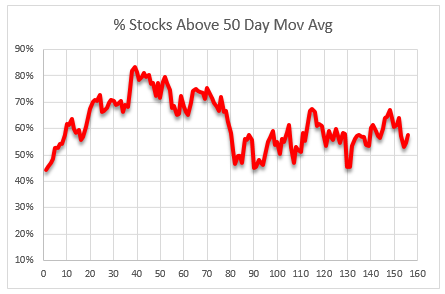
Next we have our two measures of price volatility – the VIX and Bollinger Band readings. They too are trending lower, as they have been for most of this year. What does it mean? Investors are not worried about a big decline any time soon. The market is still very quiet relative to historical readings, but pressure seems to be building for a burst of activity.
The spread between junk bond rates and Treasury bond rates is widening, which indicates a very slight uptick in concern on the part of fixed income investors.
Lastly, the number of up days out of the last 21 trading days has slipped from 16 to 12 over the last month. That’s a weak reading, but not weak enough to cause alarm.
Plot of the year-over-year % change in the S&P 500 index
The black line on this chart tracks the difference between where the market is trading today, as compared to where it was trading last year at this time. The green line shows the boundary between a typical healthy market (one that is up at least 10% from the prior year) and a market that is struggling to stay healthy.
The red line shows the boundary between a market that’s struggling to remain healthy (one that is trading between up 10% and down 10%) and one that’s in trouble (below -10%).
The term “Zone of Death” describes the area of this chart between the green and red lines. When the market enters the ZOD, it tends to succumb to a kind of gravitational pull, where it moves quickly from one boundary to the other. The closer it gets to the center of the ZOD, namely the 0% line, the stronger the gravitational pull becomes.
Today the market is comfortably above the top of the ZOD, which indicates optimism and bullishness. When the market penetrates the green line from above, it’s time to pay closer attention. Conversely, when the market penetrates the red line from below, it’s an indication that things are improving and better days are ahead.
Some takeaways
The bulls are still in charge, at least for now. Investors don’t seem to care about all the drama that’s happening in Washington. They’re focused on the promised benefits of Trump’s pro-growth agenda. This bullish trend is likely to continue, until valuations become too stretched to support higher prices and expanding P/E ratios.
Investors are showing signs of concern that their expectations for a fast rebound in earnings might be just a tad too optimistic.
Trump has a golden opportunity to boost economic growth, bring back factory jobs, and renegotiate unfair trade deals. Investors hope and expect that he will deliver on these promises.


